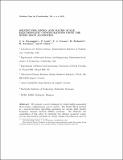SOLVING FOR MICRO- AND MACRO-SCALE ELECTROSTATIC CONFIGURATIONS USING THE ROBIN HOOD ALGORITHM
Author(s)
Lazic, Predrag; Corona, T. J.; Stefancic, Hrvoje; Abraham, Hrvoje; Gluck, Ferenc; Formaggio, Joseph A; ... Show more Show less
Downloadjoe f paper 3 robin hood.pdf (10.86Mb)
OPEN_ACCESS_POLICY
Open Access Policy
Creative Commons Attribution-Noncommercial-Share Alike
Terms of use
Metadata
Show full item recordAbstract
We present a novel technique by which highly-segmented electrostatic configurations can be solved. The Robin Hood method is a matrix-inversion algorithm optimized for solving high density boundary element method (BEM) problems. We illustrate the capabilities of this solver by studying two distinct geometry scales: (a) the electrostatic potential of a large volume beta-detector and (b) the field enhancement present at surface of electrode nano-structures. Geometries with elements numbering in the O(105) are easily modeled and solved without loss of accuracy. The technique has recently been expanded so as to include dielectrics and magnetic materials.
Date issued
2012Department
Massachusetts Institute of Technology. Department of Materials Science and Engineering; Massachusetts Institute of Technology. Department of Physics; Massachusetts Institute of Technology. Laboratory for Nuclear ScienceJournal
Progress In Electromagnetics Research B
Publisher
Electromagnetics Academy (EMW Publishing)
Citation
Formaggio, Joseph A., Predrag Lazic, T. J. Corona, Hrvoje Stefancic, Hrvoje Abraham, and Ferenc Gluck. "Solving for Micro- and Macro-scale Electrostatic Configurations Using the Robin Hood Algorithm." Progress In Electromagnetics Research B 39 (2012): 1-37.
Version: Author's final manuscript
ISSN
1937-6472